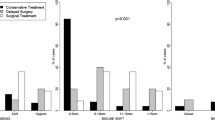Abstract
Purpose
The purpose of this study is to determine the factors associated with posttraumatic seizure in patients under 2 years old with acute subdural hematoma (ASDH).
Methods
Twenty-one patients under 2 years old (15 males and six females) with ASDH, who were admitted to our hospital between January 2002 and September 2008, were studied retrospectively. Clinical findings including birth weight and gestational age were defined. A head computed tomography scan was conducted at admission. Outcome at time of discharge was assessed using the score.
Results
Seizures occurred in eight patients (38%). Recurrent seizures occurred in three of eight patients (38%). In patients with seizures, birth weight, gestational age, and birth weight ratio were significantly lower than for those without seizure (p < 0.05).
Conclusions
Special attention should be paid to infants with ASDH who have a history of low birth weight, low gestational age, and low birth weight ratio because risk for posttraumatic seizure is considered higher in these infants than in other infants.
Similar content being viewed by others
References
Ong LC, Dhillon MK, Selladurai BM, Maimunah A, Lye MS (1996) Early post-traumatic seizures in children: clinical and radiological aspects of injury. J Paediatr Child Health 32:173–176
Hahn YS, Fuchs S, Flannery AM, Barthel MJ, McLone DG (1988) Factors influencing posttraumatic seizures in children. Neurosurgery 22:864–867
Aoki N, Masuzawa H (1984) Infantile acute subdural hematoma. J Neurosurg 61:273–280
Duhaime AC, Christian C, Moss E, Seidl T (1996) Long-term outcome in infants with the shaking-impact syndrome. Pediatr Neurosurg 24:292–298
Suh DY, Davis PC, Hopkins KL, Fajman NN, Mapstone TB (2001) Nonaccidental pediatric head injury: diffusion-weighted imaging findings. Neurosurgery 49:309–318
Lanska MJ, Lanska DJ (1996) Neonatal seizures in the United States: result of the national hospital discharge survey, 1980–1991. Neuroepidemiology 15:117–125
Vestergaard M, Basso O, Henriksen TB, Østergaard JR, Olsen J (2002) Risk factors for febrile convulsions. Epidemiology 13:282–287
Herrqard EA, Karvonen M, Luoma L, Saavalainen P, Määttä S, Laukkanen E et al (2006) Increased number of febrile seizures in children born very preterm: relation of neonatal, febrile and epileptic seizures and neurological dysfunction to seizure outcome at 16 years of age. Seizure 15:590–597
Sun Y, Vestergaard M, Pedersen CB, Christensen J, Basso O, Olsen J (2008) Gestational age, birth weight, intrauterine growth, and the risk of epilepsy. Am J Epidemiol 167:262–270
Commission on Classification and Terminology of the International League Against Epilepsy (1981) Proposal for revised clinical and electroencephalographic classification of epileptic seizures. Epilepsia 22(4):489–501
Ratan SK, Kulshreshtha R, Pandey RM (1999) Predictors of posttraumatic convulsions in head-injured children. Pediatr Neurosurg 30:127–131
Chiaretti A, De Benedictis R, Polidori G, Piastra M, Iannelli A, Di Rocco C (2000) Early post-traumatic seizures in children with head injury. Childs Nerv Syst 16:862–866
Asikainen I, Kaste M, Sarna S (1999) Early and late posttraumatic seizures in traumatic brain injury rehabilitation patients: brain injury factors causing late seizures and influence of seizures on long-term outcome. Epilepsia 40:584–589
Durham SR, Duhaime AC (2007) Basic science: maturation-dependent response of the immature brain to experimental subdural hematoma. J Neurotrauma 24:5–14
Geddes JF, Vowles GH, Hackshaw AK, Nickols CD, Scott IS, Whitwell HL et al (2001) Neuropathology of inflicted head injury in children. II. Microscopic brain injury in infants. Brain 124:1299–1306
Dixon CE, Lyeth BG, Povlishock JT, Findling RL, Hamm RJ, Marmarou A et al (1987) A fluid percussion model of experimental brain injury in the rat. J Neurosurg 67:110–119
Dzhala V, Ben-Ari Y, Khazipov R (2000) Seizures accelerate anoxia-induced neuronal death in the neonatal rat hippocampus. Ann Neurol 48:632–640
Acknowledgement
The authors thank all the patients and their families.
Conflicts of interest
The authors do not report any conflict of interest concerning the materials or methods used in this study or the findings specified in this paper.
Author information
Authors and Affiliations
Corresponding author
Rights and permissions
About this article
Cite this article
Kurabe, S., Sorimachi, T., Sasaki, O. et al. Low birth weight as a risk factor for seizure following acute subdural hematoma. Childs Nerv Syst 25, 1101–1104 (2009). https://doi.org/10.1007/s00381-009-0894-7
Received:
Revised:
Published:
Issue Date:
DOI: https://doi.org/10.1007/s00381-009-0894-7




